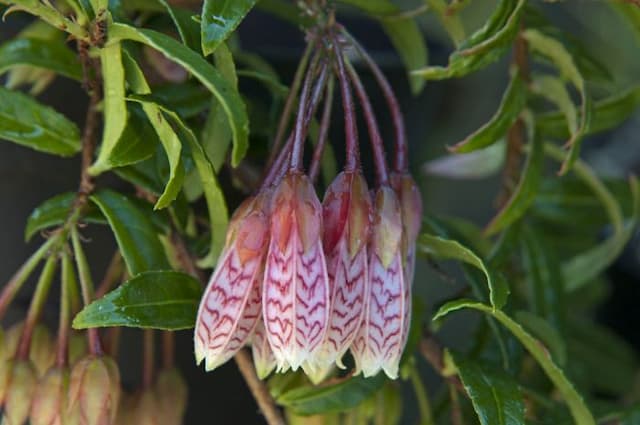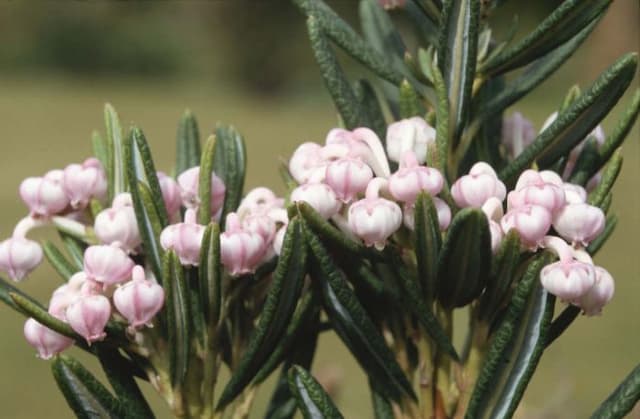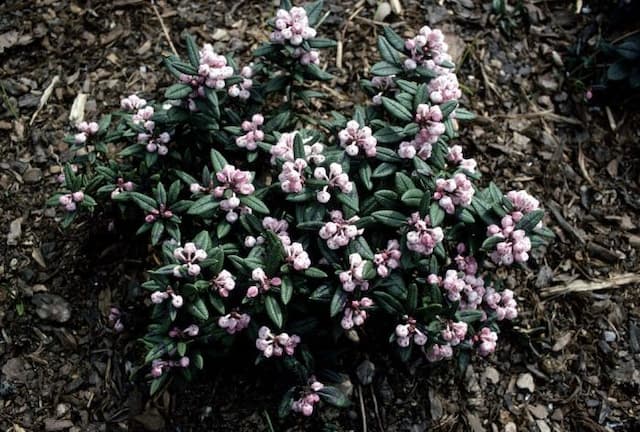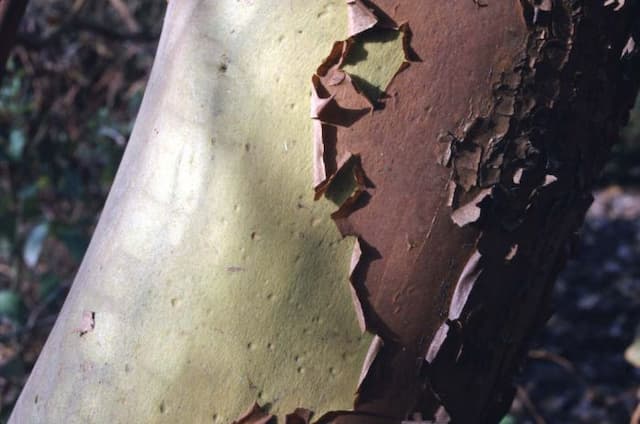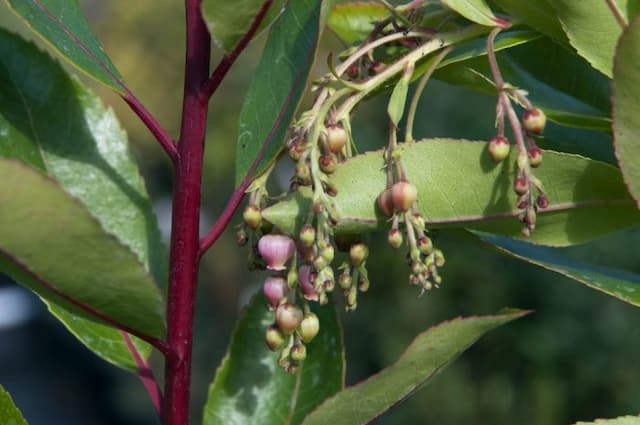Swamp Azalea Rhododendron viscosum (Vs)

ABOUT
Rhododendron viscosum, commonly known as swamp azalea, is a deciduous shrub that showcases a rich display of fragrant flowers. The blooms exhibit a striking white to pale pink color and often display a touch of yellow or a light blush. These flowers emerge from tube-like structures and fan out into a trumpet shape, with five distinct petal lobes that invite admiration and draw in pollinators. Typically flowering in the late spring to early summer, the swamp azalea's blossoms emit a pleasant aroma that can fill the air of its surrounding environment. The leaves of the swamp azalea are equally attractive, offering a lush backdrop to the radiant flowers. The foliage is characterized by a glossy, deep green hue, and each leaf is elongated with smooth edges, tapering to a defined point. As the seasons transition to autumn, the leaves may change color, adding to the visual interest of the plant. The bark and branches of the swamp azalea provide a sturdy frame for the foliage and flowers. The bark is textured and can present a rich brown to gray color, adding an earthy element to the plant's overall appearance. The branches spread to create a rounded and dense form, contributing to the lushness of the swamp azalea when in full bloom.
About this plant
 Names
NamesFamily
Ericaceae
Synonyms
Swamp Azalea, Clammy Azalea, Swamp Honeysuckle
Common names
Azalea viscosa, Rhododendron serrulatum, Azalea serrulata, Rhododendron oblongifolium, Rhododendron coryi.
 Toxicity
ToxicityTo humans
The Swamp Azalea is known to contain grayanotoxins, which can be toxic if ingested. Symptoms of poisoning may include vomiting, diarrhea, drooling, weakness, and central nervous system depression. In severe cases, ingestion can lead to cardiovascular collapse and coma. It is, therefore, important to avoid ingesting any part of the Swamp Azalea plant.
To pets
The Swamp Azalea is equally toxic to pets due to the presence of grayanotoxins. Symptoms of poisoning in pets can include vomiting, diarrhea, hypersalivation, weakness, and central nervous system depression. In severe cases, it can lead to cardiovascular collapse and potentially death. Pet owners should ensure their animals do not ingest any part of the Swamp Azalea plant.
 Characteristics
CharacteristicsLife cycle
Perennials
Foliage type
Deciduous
Color of leaves
Green
Flower color
White
Height
6-12 feet (1.8-3.7 meters)
Spread
6-12 feet (1.8-3.7 meters)
Plant type
Shrub
Hardiness zones
4-9
Native area
Eastern United States
Benefits
 General Benefits
General Benefits- Ornamental Value: Rhododendron viscosum, commonly known as Swamp Azalea, offers aesthetic appeal with its attractive flowers and can be used to enhance garden landscapes.
- Habitat Support: It provides essential habitat and food for pollinators, including bees, butterflies, and hummingbirds.
- Erosion Control: The root system of Swamp Azalea helps to stabilize soil and prevent erosion, particularly in the moist environments it prefers.
- Fragrance: The flowers of Swamp Azalea release a pleasant fragrance, which can add an olfactory dimension to gardens and landscapes.
- Seasonal Interest: Swamp Azalea offers different visual interest throughout the seasons with its blooming pattern, autumn leaf color, and the structure of bare branches in winter.
- Nature Education: The plant can be utilized in educational settings to teach about wetland ecosystems and plant biology.
- Low Maintenance: Once established, Swamp Azalea requires relatively little care, making it a practical choice for gardeners of all levels.
- Cultural Significance: Swamp Azalea has been admired for generations and is often utilized in traditional gardening practices and designs.
- Wildlife Attraction: It serves as a food source for various wildlife species, including birds and small mammals, which feed on its nectar and can be a focal point for wildlife watching.
- Adaptability: Swamp Azalea is tolerant of wet conditions and can thrive in areas where many other plants would struggle, making it useful for challenging garden spots.
 Medical Properties
Medical Properties- Antioxidant: Rhododendron viscosum may contain compounds that have antioxidant properties, helping to neutralize harmful free radicals in the body.
- Anti-inflammatory: The plant has been traditionally used to reduce inflammation, which can be beneficial in treating conditions marked by inflammation.
- Antimicrobial: Extracts from the plant are believed to have antimicrobial effects, potentially effective against certain bacteria and fungi.
- Analgesic: There is some indication that Rhododendron viscosum may have pain-relieving properties.
- Cardioprotective: Some species of Rhododendron have been studied for their potential heart-protective effects, though specific research on Rhododendron viscosum is limited.
 Air-purifying Qualities
Air-purifying QualitiesThis plant is not specifically known for air purifying qualities.
 Other Uses
Other Uses- Rhododendron Swamp Azalea is utilized in landscape design to create visually striking deciduous shrub borders, especially favored for its fragrant flowers and attractive fall foliage.
- The nectar from Swamp Azalea flowers is sought by beekeepers for a distinctively flavored honey which is a regional specialty in areas where the plant is native.
- The Swamp Azalea's dense growth habit provides shelter and nesting sites for various bird species, making it an ecological contributor to sustaining local avian populations.
- Due to its wetland habitat, Swamp Azalea plays a role in water purification by trapping sediments and absorbing pollutants, contributing to cleaner aquatic ecosystems.
- The plant has been used in ecological restoration projects to stabilize soil in wetland areas, helping to reduce soil erosion and create habitats for wildlife.
- Swamp Azalea is sometimes used in bonsai cultivation, where its unique flower and leaf structure enable enthusiasts to create miniature landscapes.
- The fibrous roots of the Swamp Azalea can be utilized in traditional basket-weaving, although this is not a common practice.
- In some cultures, the vibrant blooms of the Swamp Azalea are used for natural dyes, though this use is not widely documented.
- Swamp Azalea is used in aromatic therapy; its sweet scent is said to be relaxing and used to scent rooms or clothing, but care must be taken due to its toxic nature when ingested.
- During certain festivals, the blooms of Swamp Azalea have been used as decorations to create garlands or as part of floral arrangements for their aesthetic value.
Interesting Facts
 Feng Shui
Feng ShuiThe Swamp Azalea is not used in Feng Shui practice.
 Zodiac Sign Compitability
Zodiac Sign CompitabilityThe Swamp Azalea is not used in astrology practice.
 Plant Symbolism
Plant Symbolism- Warning or Caution: Rhododendron, including the species Rhododendron viscosum commonly known as Swamp Azalea, can symbolize a warning or caution because some species contain toxic substances that are harmful if ingested.
- Abundance and Wealth: Swamp Azalea's abundance of flowers can symbolize prosperity and wealth.
- Elegance and Sophistication: With its beautiful, showy blooms, Swamp Azalea often represents elegance and sophistication in the language of flowers.
- Homecoming and Reunion: As a plant that is hardy and returns with blooms each year, Swamp Azalea can signify a joyous homecoming or reunion.
- Temperance: In Victorian flower language, Rhododendrons were sometimes used to symbolize temperance or moderation, possibly due to their toxic properties urging moderation in their presence.
 Water
WaterSwamp Azalea should be watered thoroughly, allowing the water to soak into the soil to reach the root zone. It prefers consistently moist soil, so watering should occur once or twice a week, depending on weather conditions. During hot or dry periods, water may be needed more frequently. It's important to avoid waterlogged soil, so ensure good drainage. It may require approximately 1 gallon of water per week for smaller shrubs, increasing as the plant grows.
 Light
LightSwamp Azalea thrives best in partial shade to partial sun. The ideal spot for this plant would receive morning sunlight and afternoon shade or dappled sunlight throughout the day. Avoid exposing it to intense afternoon sun as it can damage the foliage.
 Temperature
TemperatureSwamp Azalea is hardy and can survive in temperatures as low as 0°F and as high as 90°F. However, the ideal temperature range for the plant is between 50°F and 70°F. Ensure the plant is protected from extreme cold winds and heat stress by providing a suitable location.
 Pruning
PruningPrune Swamp Azalea to maintain its shape and encourage bushier growth. The best time for pruning is immediately after the blooming period ends in early summer. Pruning should be done annually or as needed to remove any dead or diseased branches and to control the size of the plant.
 Cleaning
CleaningAs needed
 Soil
SoilSwamp Azalea thrives in acidic, well-draining soil with a pH of 4.5-6. A mix of pine bark, sphagnum peat moss, and perlite in equal parts creates an ideal environment for this plant.
 Repotting
RepottingSwamp Azalea should be repotted every 2 to 3 years to refresh the soil and accommodate root growth, ideally in the spring before blooming.
 Humidity & Misting
Humidity & MistingSwamp Azalea prefers high humidity levels, typically around 50-60%, which can be maintained by placing the plant in a naturally humid environment or using a humidifier.
 Suitable locations
Suitable locationsIndoor
Provide bright, indirect light and maintain high humidity.
Outdoor
Plant in partial shade with well-draining, acidic soil.
Hardiness zone
5-9 USDA
 Life cycle
Life cycleRhododendron viscosum, commonly known as Swamp Azalea, begins its life cycle as a seed, typically requiring a period of cold stratification to break dormancy before germination occurs. Upon germination, the seedling emerges and grows, developing a root system and foliage; this young plant stage can last for several years as it matures. The juvenile phase transitions to the adult vegetative stage, where the Swamp Azalea grows and expands, but is not yet reproductive. With maturity, the plant enters the reproductive stage, characterized by the production of fragrant white to pale pink flowers in late spring to early summer, which are pollinated by insects, leading to the development of seed capsules. After seed dispersal in late summer to autumn, the plant may enter a period of dormancy, particularly in cooler climates, where it conserves energy before the next growth cycle. Throughout its life, the Swamp Azalea may also spread asexually through the rooting of branches that come in contact with the soil, a process called layering.
 Propogation
PropogationPropogation time
Spring-Early Summer
The most popular method of propagating Rhododendron viscosum, commonly known as Swamp Azalea, is through semi-hardwood cuttings. This technique is typically done in late summer. The process involves selecting healthy, disease-free shoots that have started to mature and develop a woody base. Cuttings should be about 4 to 6 inches long (10 to 15 cm) and include several leaf nodes. The lower leaves are removed, and the cut end can be dipped in a rooting hormone to encourage root development. Cuttings are then placed in a well-draining potting mix and kept in a humid environment with indirect light until they have rooted, which can take several weeks. Constant moisture and avoiding direct sunlight are crucial for the successful rooting of Swamp Azalea cuttings.
